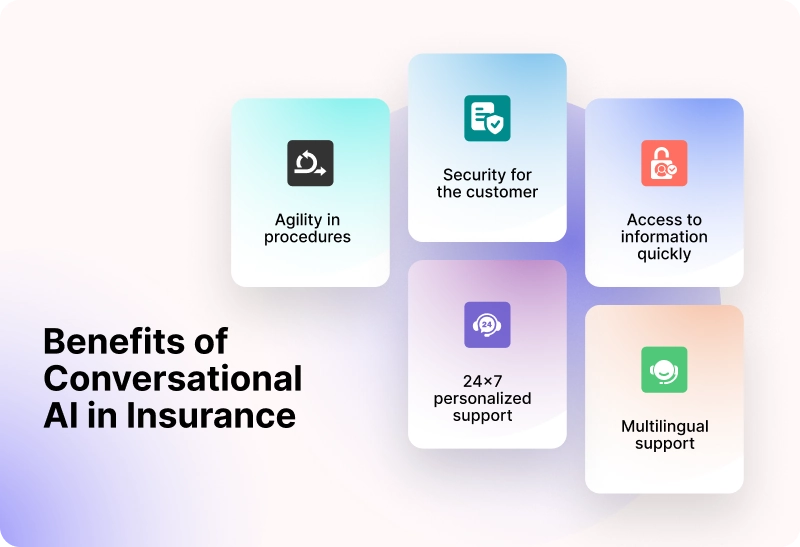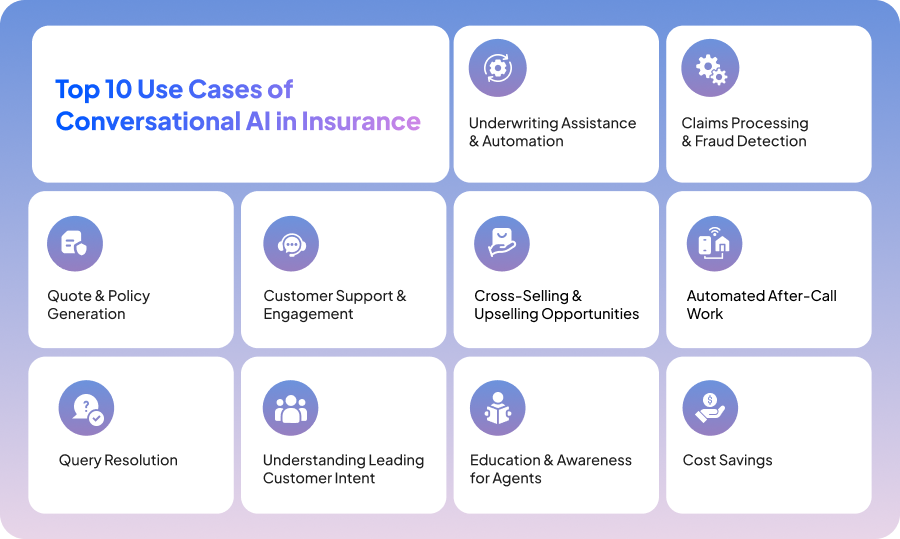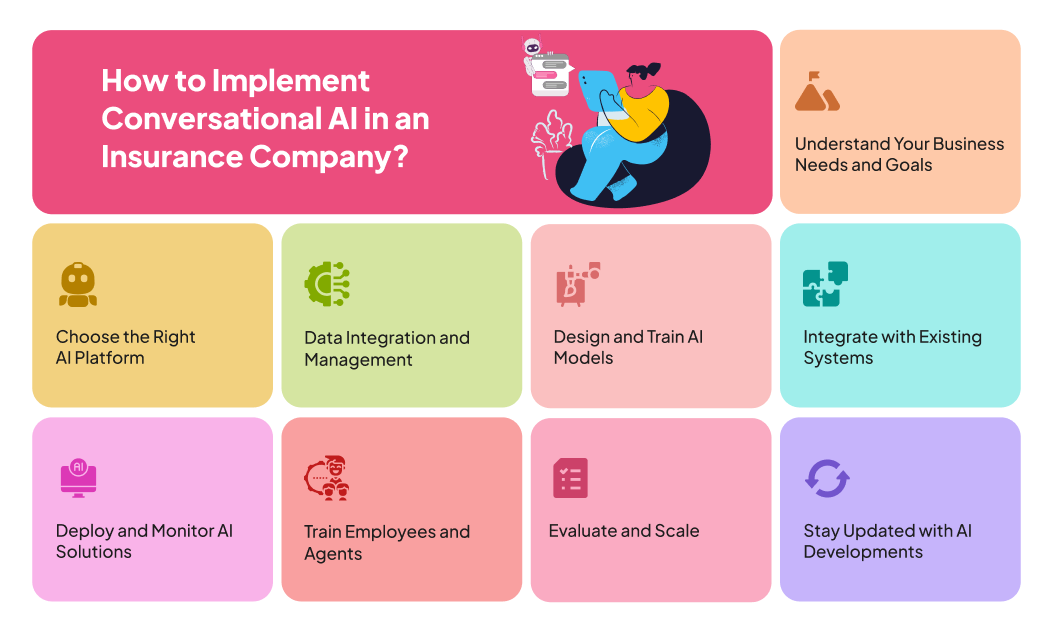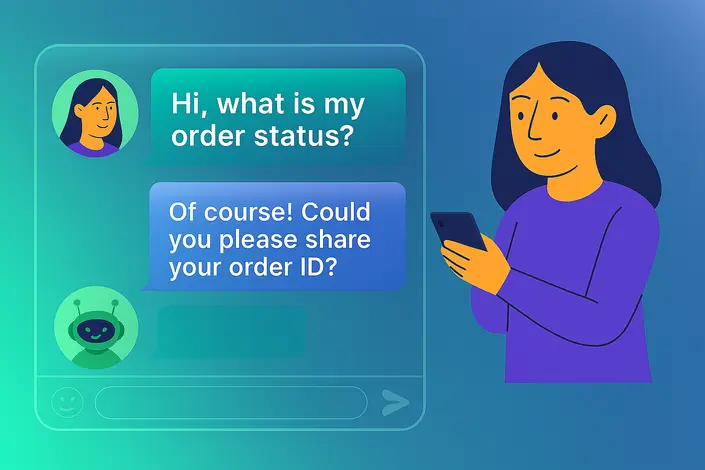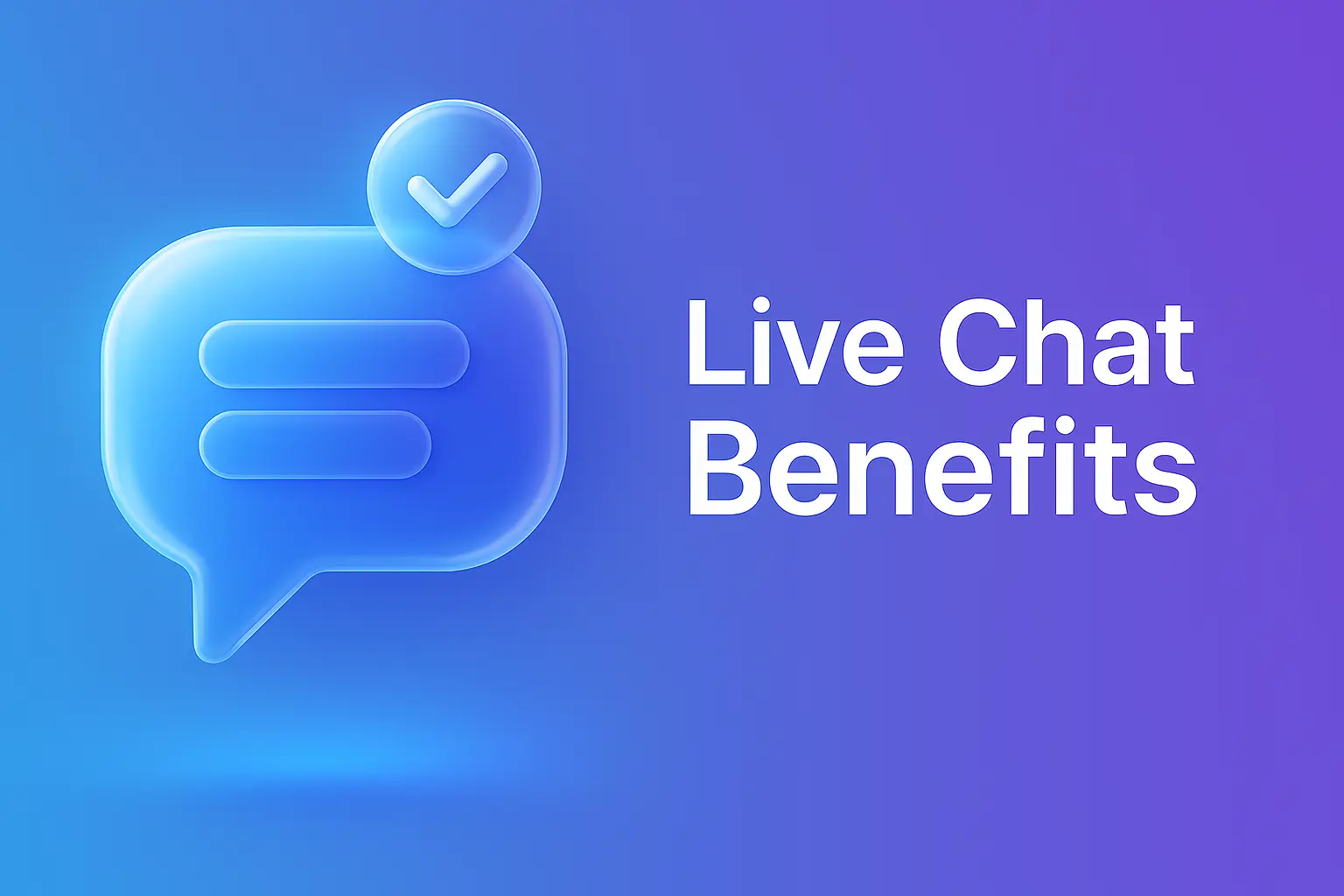Conversational AI in Insurance: Benefits & Use Cases
- October 15, 2024
- 16 mins read
- Listen

Imagine a world where customers search for insurance products and services in a hassle-free and effortless way. They ask questions, seek advice, and receive answers that are tailored to their unique needs. Welcome to the era of Artificial Intelligence, where Conversational AI becomes the bridge between your experience and understanding your customers, facilitating meaningful interactions that empower them to make informed decisions.
Conversational AI is not just about providing answers; it is about understanding the intent behind the questions. It is about speaking your customers’ language, addressing their concerns, and making them feel valued.
According to a report by Gartner, 75% of customer interactions will be handled without a human agent by 2025, underscoring the growing importance of AI in customer service.
In this article, we will explore the cases of conversational AI in insurance companies and look into the substantial benefits that insurance companies can gain by implementing AI-powered customer service. Let’s begin.
What is Conversational AI?
Conversational AI is a technology that enables machines to interact with humans naturally. It is a subset of artificial intelligence that leverages concepts like neural networks, machine learning, and others. And makes them available to build useful applications with it. Like hands-free control, while driving, Siri is waiting for your commands, or even virtual agents that assist in customer support on phone lines.
Conversational AI has two key components.
- The first component is Natural Language Understanding (NLU). It is a driven capability that can extract meaning from written or spoken text. Think of something simple like asking, “What time is it?” There are many ways humans can express this question and NLU can process them in real-time and recognize the underlying intent. It’s what makes the conversational AI smart.
- The second component is the ability to deploy NLU to action. It is the toolbox that brings AI-powered conversations to life for the end user’s screens, devices, cars, and so on. And, it connects them with whatever is needed to reach their goals like playing a song, resetting a password, filing an insurance claim, or anything that can be done with language. This enables them to not only chat but also get things done.
Connection Between Conversational AI and Insurance
Conversational AI is transforming the insurance industry by enhancing customer service, streamlining operations, and improving data analysis. Insurance companies are using AI-powered chatbots and virtual agents to handle routine inquiries, provide policy advice, and simplify the claims process.
Additionally, AI helps insurers predict customer behavior and preferences, leading to more proactive solutions. As a result, the adoption of conversational AI is expected to significantly reduce labor costs and keep insurers competitive in a rapidly changing market.
According to a Gartner study, “ by 2026, conversational artificial intelligence (AI) deployments within contact centers will reduce agent labor costs by $80 billion.”
Benefits of Conversational AI in Insurance
Conversational AI shows a high degree of empathy with users, which avoids friction and improves the experience of users as sensitive as those in the insurance sector. It plays a significant role and provides various benefits. That is why, more insurance leaders prioritize investment in conversational AI for their competitiveness and growth plans.
The conversational AI applied to the insurance sector, paradoxically, reveals a more human side with multiple advantages that we will tell you about right away:
1. Agility in Procedures
The conversational AI can reduce response time by up to 80%. This equates to faster customer service and a greater number of satisfied customers. The reason for this satisfaction is that users value agility as one of the key elements for having a good experience, especially in processes as sensitive as insurance company procedures.
In this sense, conversational AI for insurance companies can:
- Guide users, clients, or prospects.
- Clarify doubts.
- Guide on the website in self-management processes.
- Send and receive documents.
- Share information on face-to-face service.
- Create second-level service request cases.
- Refer users to human agents.
2. Security for the Customer
Conversational AI is developed with complex algorithms and highly secure protocols that minimize the vulnerabilities of your system. This is why they are not only a fast and effective intelligent assistant, but also provide high security and data protection.
There are four ways to secure conversational AI in insurance. It includes encryption, authentication, processes & protocols, and education. Some other methods can be used by the customers, such as Self-erasing messages and a Web Application Firewall (WAF).
Therefore, in the case of conversational AI, security is not a weak point, on the contrary, it becomes a clear advantage and strength for the insurance companies that implement it.
3. Access to Information Quickly
Conversational AI in insurance companies meets this need for quick access to information. As we know, plans, policies, coverage, and procedures in the insurance sector handle a large volume and complexity of data, so it is tedious for users to obtain information at different stages.
This is where the functionality of the conversational AI shines, as it is capable of managing the data obtained in its management and that which has been inherited from other company platforms (CRM, ERP, networks, documents, etc.), to find and share the information that users need.
4. 24×7 Personalized Support
Conversational AI provides customers with round-the-clock service, addressing queries related to policies, claims, and other insurance-related matters without the need for human intervention.
For example, by not having a conversational AI, insurance companies must have a human contact center team under a rotation that allows them to cover this need for service 24 hours a day, 7 days a week. Of course, this situation increases costs in infrastructure, and personnel administration and can negatively impact the quality of life of workers.
In turn, this situation would not be entirely effective, since it would not be possible to cover and centralize all the number of channels that can be managed simultaneously with conversational AI platforms for insurance companies. Regarding this integration capacity, we can use REVE Chatbot as an example. It develops chatbots that can be easily integrated into various communication channels (social networks, websites, WhatsApp, and others).
5. Multilingual Support
Conversational AI in insurance supports multi-language. This benefits the insurance companies to serve a diverse global customer base. This capability ensures that customers can interact in their preferred language, improving accessibility and customer satisfaction.
REVE Chat conversational AI supports 25+ languages which helps insurance companies expand into new markets by providing localized support and understanding cultural nuances.
The benefits above showcase just a fraction of conversational AI’s transformative power in the insurance industry. Implementing a conversational AI solution can unlock numerous benefits, including significantly reducing response times, enhancing data security, and providing 24/7 personalized support.
Top 10 Use Cases of Conversational AI in Insurance
Conversational AI is becoming integral to the insurance industry, streamlining processes, improving customer experiences, and reducing operational costs. A consumer might make deals with insurers considering these four key areas. Buying or newing a policy, Making a change, Making a claim, and Canceling the deal. There is a good opportunity for conversational AI to fit in all of those four areas. Let’s take a closer look at the use cases of Conversational AI in Insurance:
1. Underwriting Assistance & Automation
Conversational AI can significantly enhance the underwriting process by automating data collection and analysis. AI-driven chatbots can gather necessary information from customers in real-time, assess risk profiles, and provide recommendations to underwriters. This not only speeds up the underwriting process but also ensures more accurate risk assessments.
According to an Accenture report, 74% of insurance executives believe that AI will significantly change the underwriting function by 2025.
2. Claims Processing & Fraud Detection
AI-driven chatbots and virtual agents can automate claims intake, guide customers through the process, and even detect fraudulent claims by analyzing patterns and anomalies. This reduces the time taken to process claims and minimizes losses due to fraud. McKinsey reports that AI has the potential to reduce claims processing costs by up to 30% while improving accuracy and customer satisfaction.
3. Quote & Policy Generation
Conversational AI can assist customers in generating quotes and selecting policies tailored to their needs. AI-powered tools can analyze customer data and preferences, providing personalized policy recommendations in real-time. This not only enhances the customer experience but also increases conversion rates. A study by Juniper Research found that AI chatbots will help insurance companies save over $1.3 billion in operational costs.
4. Customer Support & Engagement
AI-powered virtual assistants can handle a wide range of customer queries, from basic policy information to complex claim issues. They provide 24/7 support, ensuring customers always have access to assistance. This leads to higher customer satisfaction and loyalty. Gartner predicts that by 2026, AI-driven customer service will lead to an 80% reduction in contact center operational costs.
5. Cross-Selling & Upselling Opportunities
Conversational AI can analyze customer behavior and preferences to identify opportunities for cross-selling and upselling. By offering personalized recommendations, insurers can increase the average revenue per customer. According to Accenture, companies using AI for customer engagement have seen a 10-15% increase in sales.
6. Automated After-Call Work
After customer interactions, conversational AI can automatically log details, update records, and complete necessary follow-up tasks. This automation reduces the workload on human agents and increases overall efficiency. The adoption of AI in insurance is expected to reduce after-call work time by 30-50%, according to Deloitte.
7. Query Resolution
AI-driven tools can resolve customer queries quickly and accurately, often without the need for human intervention. This reduces wait times and improves customer satisfaction. According to a report by Forrester, companies using AI for query resolution have seen a 20% improvement in first-contact resolution rates.
8. Understanding Leading Customer Intent
A PwC study found that 67% of customers expect businesses to understand their individual needs. Conversational AI can analyze interactions to identify customer intent, helping insurers to better understand customer needs and preferences. This insight allows companies to tailor their offerings and improve customer engagement.
9. Education & Awareness for Agents
AI can be used to train and support insurance agents by providing them with real-time information and insights. This helps agents to stay informed about products, policies, and customer needs, leading to more effective customer interactions. According to a report, 60% of insurance companies are investing in AI to enhance agent training and support.
10. Cost Savings
The adoption of conversational AI leads to significant cost savings for insurers by automating processes, reducing operational costs, and improving efficiency. Gartner estimates that by 2026, conversational AI could reduce labor costs in contact centers by up to $80 billion.
Conversational AI is transforming insurance. It’s making things faster, cheaper, and better for both customers and companies. From underwriting and claims processing to customer service and sales, AI is streamlining operations, enhancing customer experiences, and driving significant cost reductions.
By automating routine tasks, providing personalized insights, and detecting fraud, AI is empowering insurers to adapt to evolving customer expectations and market dynamics. And, creating a more efficient, customer-centric, and profitable insurance sector.
Conversational AI Usage in Various Insurance Segments
Conversational AI is revolutionizing the insurance industry by enhancing efficiency, improving customer experiences, and streamlining operations across various segments. The following table highlights the key utilities and benefits of conversational AI in each insurance segment.
|
Insurance Segments |
Conversational AI Usage |
Benefits |
|
Health Insurance |
|
|
|
Life Insurance |
|
|
|
Auto Insurance |
|
|
|
Homeowners Insurance |
|
|
|
Commercial Insurance |
|
|
|
Travel Insurance |
|
|
|
Pet Insurance |
|
|
|
Marine Insurance |
|
|
|
Crop Insurance |
|
|
How to Implement Conversational AI in an Insurance Company
Implementing conversational AI in an insurance company involves a strategic approach that ensures the technology effectively addresses the company’s needs and enhances customer experiences. Here’s a step-by-step guide to help you implement conversational AI in an insurance company:
Step 1: Understand Your Business Needs and Goals
The first step of implementing a conversational AI in insurance is to identify your business pain points. Determine where conversational AI can have the most impact, such as improving customer service, automating claims processing, or enhancing underwriting. You need to set clear objectives and goals. Define what you want to achieve with AI, whether it’s reducing operational costs, improving customer satisfaction, or increasing efficiency.
Step 2. Choose the Right AI Platform
After identifying your business pain points, select an AI platform that aligns with your company’s specific needs. For instance, platforms like REVE Chat’s conversational AI cater to business-specific requirements across various platforms and allow customization.
Step 3. Data Integration and Management
You need to gather relevant customer data from various sources like CRM systems, claims databases, and policy management systems. Clean and organize the data to ensure accuracy and reliability, as AI’s effectiveness depends on high-quality data. Implement robust data security measures to comply with regulatory standards and protect sensitive customer information.
Step 4. Design and Train AI Models
Now, you know where you want to get started. You’ve picked the role your conversational AI is going to take, which part of the business, who’s going to speak to, and what are the top contacts it’s going to help with. It’s time to train and design your conversational AI.
You can train your conversational AI into three clear categories:
- Language:
Your conversational AI needs to know the domain language for the role it’s taking on. Develop Natural Language Processing (NLP) models that can understand and respond to your customer inquiries in a natural, conversational manner.
- Process:
As your conversational AI learns how to speak the language of that domain. It now needs to know the process because conversational AI is about dialogue, interaction, about solving a problem. It’s not about being rigid. You need to train your conversational AI to learn the standard operating procedure that a human would follow to solve a problem.
- Knowledge:
You need to keep a backing system so that the conversational AI can query in real-time to get relevant information, help it follow the process, and use the language it knows to help solve a problem.
Step 5. Integrate with Existing Systems
Now you need to ensure that the AI system integrates smoothly with existing platforms like CRM, claims management, and customer service tools. Use APIs and middleware to facilitate communication between the AI system and other software within the company’s IT infrastructure.
Step 6. Deploy and Monitor AI Solutions
Start with a pilot program in a specific department or for a particular use case to test the AI system’s effectiveness. And, continuously monitor AI performance through metrics like response time, customer satisfaction, and cost savings. Additionally, you need to collect feedback from users and customers to identify areas for improvement and make necessary adjustments.
Step 7. Train Employees and Agents
Educate your employees and agents on how to use the AI tools effectively, emphasizing the ways it can assist rather than replace their roles. Also, provide continuous support and resources to help staff adapt to the new technology and integrate it into their daily workflows.
Step 8. Evaluate and Scale
Measure your company’s ROI and the impact of conversational AI on key business metrics such as customer satisfaction, operational efficiency, and cost reduction. Once the pilot is successful, gradually scale the AI implementation across different departments and use cases within the company.
Step 9. Stay Updated with AI Developments
Stay informed about advancements in AI technology and update the AI models regularly to keep up with new trends and improvements. Be prepared to adapt the AI system to evolving customer needs and market conditions, ensuring it remains relevant and effective.
The Future of Conversational AI in Insurance
The digitalization of processes in the insurance industry has grown in recent years and is expected to continue to increase in the future. According to a recent report, the global market is expected to experience an annual growth of 29.1% until 2028, generating a business volume of around $58 billion.
The future of conversational AI in insurance is poised for significant growth, with industry experts predicting widespread adoption and substantial benefits. According to a report by Juniper Research, AI-driven chatbots will save insurance companies over $7.3 billion in operational costs.
This growing reliance on conversational AI is expected to transform customer engagement, streamline claims processing, and improve underwriting accuracy, making it a critical tool for insurers to remain competitive in a rapidly evolving market.
The Most Comprehensive Conversational AI solution for the Insurance Industry
REVE Chatbot is a powerful conversational AI solution for the insurance industry. It is designed to enhance customer interactions and streamline operations. It provides instant, personalized support, and ensures policyholders receive accurate information and prompt assistance 24/7.
With REVE Chatbot, all customer interactions are recorded and easily accessible which ensures transparency and smooth follow-ups. Its advanced keyword tracking helps you monitor terms like “policy” and “claim,” and enables you to understand customer needs, predict outcomes, and tailor services effectively.
Key Features of REVE Chatbot
- Bulk ML training for quick adaptation
- Easy scalability
- Seamless human handover for complex queries
- Appointment scheduling
- Advanced Reporting
- Sentiment analysis
These features ensure that REVE Chatbot grows with your business, transforms your customer interactions, and drives growth in the insurance industry.
Final Thoughts
In the insurance space, where trust and connection are of utmost importance, Conversational AI (Artificial Intelligence) is your ally. It allows you to connect with your customers on a human level, using the power of technology to nurture relationships. It’s time to embrace conversation and enter a future where your customers’ expectations are not only met but exceeded.
With solutions like the REVE Chat platform with templates developed specifically for insurance companies, our automation solutions are ready to answer your customers’ most frequently asked questions and put you on the path to streamlining workflows, reducing costs, and ultimately taking your customer service to the next level.
If you’re ready to take the next step to elevate your customer’s experience, contact us for more information.
Frequently Asked Questions
Yes, conversational AI can be seamlessly integrated with existing insurance systems. Most advanced AI platforms, like REVE Chatbot, are designed to work alongside your current infrastructure, including CRM, ERP, and other backend systems.
No, AI will not replace insurance agents but will instead complement their work. Conversational AI can handle routine tasks like answering common queries, processing claims, and providing policy information, freeing up agents to focus on more complex and personalized interactions that require human expertise.
A conversational AI can be used in insurance to improve customer service, streamline operations, and enhance overall efficiency. Here are some key applications: 1. Customer Support,
2. Policy Management, 3. Claims Processing, 4. Fraud Detection, 5. Cross-Selling & Upselling, 6. Appointment Scheduling, 7. Education & Awareness.
Yes, conversational AI is suitable for both large and small insurance companies.
For large insurance companies, conversational AI can handle high volumes of customer interactions, streamline complex processes, and manage data across multiple systems. For small insurance companies, conversational AI offers a cost-effective way to improve customer service and compete with larger firms.
Conversational AI solutions improve customer satisfaction in the insurance sector by providing faster, more personalized, and accessible service. It provides: 1. 24/7 Availability, 2. Instant Responses, 3. Personalization, 4. Streamlined Processes, 5. Multilingual Support, 6. Proactive Engagement.

